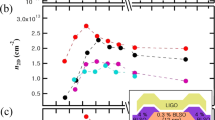Abstract
The details of the formation, propagation, interaction, and densities of misfit dislocations are combined into a simple model quantitatively predicting dislocation densities for both abrupt and graded heterojunctions. Three key concepts are introduced: (1) misfit dislocations are segmented; (2) accordingly, they must give rise to a density of inclined dislocations, n I, that propagate through the growing layer; and (3) these inclined dislocations can bend in and out of any subsequently formed misfit plane to relieve the strain, and when bent in, serve as strain-relieving misfit dislocations. Thus, the value of n I is expected to remain constant with thickness. Also, n I is predicted to vary directly with the compositional gradient at the heterojunction. It is pointed out that there are two general classes of misfit dislocations, pure-edge and mixed and that their intersections, which cause the misfit dislocations to appear to bend within their plane, can be simply classified into three general types.
Transmission electron microscopy was used for a comprehensive study of dislocations in a series of GaAs1−xPx heterojunctions prepared by a vapour phase growth technique. The main features of the above model were corroborated. The value of n I was found to be constant with growth distance as postulated, and in quantitative agreement with prediction, n I decreased from 4 × 107 cm−2 to 106 cm−2 as the compositional gradient decreased from 5% phosphorus/μm to 0.2% phosphorus/μm. Note that these values can far exceed the dislocation density of the substrates. Of particular significance, the inclined dislocations n I were found to propagate through a constant-composition region grown on top of a compositionally graded region, so that formation of the heterojunction must affect subsequently grown layers. Finally, it is shown that the misfit dislocations are, indeed, a combination of pure-edge and mixed, and all three postulated general interactions between these dislocations are shown to occur.
Similar content being viewed by others
References
R. L. Anderson, Solid-State Electron 5 (1962) 341.
H. Kromer, Proc. IRE 45 (1957) 1537.
D. A. Jenny, ibid 46 (1958) 959.
J. J. Tietjen et al, Trans. AIME 239 (1967) 385.
C. J. Nuese et al, ibid 242 (1968) 400.
R. E. Enstrom, to be published.
D. Richman and J. J. Tietjen, Trans. AIME 239 (1967) 418.
F. C. Frank and J. H. Van Der Merwe, Proc. Roy. Soc. A198 (1949) 216.
M. S. Abrahams and C. J. Buiocchi, J. Appl. Phys. 37 (1966) 1973.
R. S. Mroczkowski, A. F. Witt, and H. C. Gatos, J. Electrochem. Soc. 115 (1968) 750.
M. S. Abrahams and C. J. Buiocchi, J. Appl. Phys. 36 (1965) 2855.
J. H. Van Der Merwe, ibid 34 (1963) 117; 34 (1963) 123.
W. A. Jesser and D. Kuhlmann-Wilsdorf, Phys. Status Solidi. 19 (1967) 95.
F. C. Frank “Defects in Crystalline Solids” (The Physical Society, London, 1955) p. 166.
J. W. Matthews “Single Crystal Films”, edited by M. H. Francombe and H. Sato (The MacMillan Co, New York, 1964) p. 167.
J. J. Tietjen and J. A. Amick, J. Electrochem. Soc. 113 (1966) 724.
M. S. Abrahams, C. J. Buiocchi, and M. D. Coutts, Rev. Sci. Instr. 39 (1968) 1944.
E. Levine, J. Washburn, and G. Thomas, J. Appl. Phys. 38 (1967) 81.
J. W. Matthews and W. A. Jesser, Acta Met. 15 (1967) 595.
R. Siems, P. Delavignette, and S. Amelinckx, Phys. Status Solidi. 2 (1962) 421.
P. B. Hirsch, A. Howie, and M. J. Whelan, Phil. Trans. Roy. Soc. A252 (1960) 499.
Author information
Authors and Affiliations
Rights and permissions
About this article
Cite this article
Abrahams, M.S., Weisberg, L.R., Buiocchi, C.J. et al. Dislocation morphology in graded heterojunctions: GaAs1−xPx . J Mater Sci 4, 223–235 (1969). https://doi.org/10.1007/BF00549922
Received:
Revised:
Issue Date:
DOI: https://doi.org/10.1007/BF00549922



